Year, Country | Produced by
In this box you will add the description of the case study.
PRODUCT ENVIRONMENTAL SUSTAINABILITY
►
LIFE CYCLE DESIGN STRATEGY
Add LCD strategy
►
SUB-STRATEGY
Add Sub-strategy
►
GUIDELINE
Add guideline
2015-2019
Promoter and coordination of the EU-supported (ERASMUS+) project.
Multipolar and open network of networks for curricula development on Design for Sustainability, focused on Sustainable Product-Service Systems (S.PSS) applied to Distributed Economies (DE), funded by the European Union Erasums+ program (multiregional with 36 universities as partners and associate partners from Mexico, Brasil, South Africa, India, China and in Europe UK, Finland, The Netherlands, and Italy).
This will close in 0 seconds
2013-2016
Promoter and coordination for the international research.
Multi-polar and open network for curricula and lifelong learning capacity development on System Design for Sustainable Energy for All (SD4SEA) focused on Sustainable Product-Service System applied to Distributed Renewable Energies (DRE), funded by the European Union Edulink program (bi-regional with Africa).
This will close in 0 seconds
2012-2015
National coordinator for the international research, funded by the European Union Life+ program.
The Sustainability Maker project, promotes open innovation, crowd-sourcing, crowd-voting, crowd-funding platforms, and an online marketplace for Sustainable Solutions (www.sustainabilitymaker.org – www.innonatives.com). The platform combines a website and mobile application, to connect people who have identified sustainability-related problems with those who like to help to develop creative problem-solving solutions and support their implementation.
The SuM project has published on the platform several Design Challenges related to climate change, energy, resource efficiency, water, food, and agriculture/land use, urban environment, waste, and recycling; and encourages the innovation community of the Sustainability Maker platform to develop solutions to solve these problems. The ideas/concepts/solutions submitted are voted by the crowd (crowd-voting) and sustainability experts. The best solution(s) can be implemented either by the external actors who formulated the challenge or by other members of the platform and additional stakeholders (e.g. crowd-funding).
This will close in 0 seconds
2011-2013
National coordination for the international research funded by the European Union Culture program.
In this European level culture project, contemporary, sustainable and accessible design meets different European audiences of different age groups. The project brings forth issues of creativity, social design, and sustainability, and promotes intergenerational dialogue in three European countries: Finland, France, and Italy. The project explores different forms of sustainable design and how users, consumers, and audiences of different ages perceive them. One of the main results of the project is traveling exhibitions named TANGO, aiming at being a lab and a window to diffuse sustainable innovations.
This will close in 0 seconds
2007-2010
Promoter and coordinator of the international research, funded by the European Union Asia Links program, EuropAid, bioregional with Asia.
The Learning Network on Sustainability – LeNS is a 3 years project, involving 7 design schools in Europe and Asia, to develop an Asian-European multi-polar network for curricula development on Design for Sustainability focused on Product-Service System and to contribute to curriculum development, in a reciprocal understanding of cultures, by promoting a new generation of designers (and design educators) capable to effectively contribute to a transition towards a sustainable society.
LeNS promotes a new shared and articulated disciplinary ground on Design for Sustainability focused on Product-Service System, through a series of exchange activities and pilot courses at the partner institutions. LeNS has produced an open learning e-package, a modular package of teaching materials (texts, slide shows, audio, video, etc.) and tools for designers that design educators worldwide are able to download (free of charge), modify/remix and reuse (copyleft).
LeNS also promotes diffusion activities targeting the design community worldwide. As a project spin-off, the following affiliated HEIs network was established: LeNS Africa, LeNS South America, LeNS Central America, LeNS Oceania, LeNS German Speaking Languages, LeNS China, and LeNS India.
This will close in 0 seconds
2005-2008
Coordinator of the design area for the international research, funded by the European Union, 6° Framework program.
Sustainable consumption and production (SCP) is key policy priority world-wide. In our view, sustainable consumption and production structures can only be realized if experts that understand business development, (sustainable) solution design, consumer behavior and effectiveness of (policy) instruments work together in shaping them. Furthermore, this should be linked with the experiences of actors (industry, consumer groups, ecolabelling organizations) in real-life consumption areas.
Since in the EU a network with these characteristics is absent, this project sets up a Co-ordination action on SCP, emphasizing “user awareness” for sustainable consumption, involving key expertise covering all relevant steps of the value chain in the priority consumption domain s Mobility, Agro-Food, and Energy/electronics. These domains contribute to over 70% of the life cycle impacts of household consumption, are a priority in the EU's Environmental Technologies Action Plan (ETAP), and give good examples of user awareness schemes (e.g. labeling).
The CA is organized around a series of Workshops and Conferences. The first workshop will provide a general exchange of views. The second phase of the project gives sustainable consumption cases in the domains center stage. These are used as vehicles for a positive confrontation of insights from different science fields, leading to true best practice generation, suggestions for implementation of user awareness approaches, research programming, and development of conceptual insights. The science and consumption domains are covered by 8 WP leaders and 21 Participants and will involve a much larger community of SCP experts from industry, government, and science. A close liaison with UNEP, promoting a 10 Year Framework of Programs on SCP will be organized. Finally, the CA should have to build a permanent, self-supporting research network in this field.
This will close in 0 seconds
2007-2008
Coordinator of the design area for the research.
Focused on the development of System design for a sustainable pilot project aiming at an introduction of locally-based and long-lasting mobility system for low-income contexts in Africa, within the international research Global UNIDO Network of University Chairs on Innovation, involving some African and some European universities (among which the Politecnico di Milano).
This will close in 0 seconds
2001-2004
Coordination of the design area for the international research, coordinated by PricewaterhouseCoopers (PwC), funded by the European Union, 5° Framework program.
The aim of this project was to develop an integrated methodology for the design of sustainable Product Service Systems (PSS), starting from three main thematic areas:
– PSS design (scenario development and sustainable PSS design)
– Assessment of environmental impacts (impact on micro, meso, and macro level)
– Success and failure factors (consumer acceptance, culture, and ethics)
These diverse approaches are converged in a unique methodology. The application of a common language as well as the definition of an ideal design process was crucial.
MEPSS is part of the Competitive and Sustainable Growth Programme of the Fifth Framework Programme, coordinated by PricewaterhouseCoopers N.V. with eight partners and 14 subcontractors.
The dimension of this project is strictly necessary, as its strength lies in its multidisciplinarity. This allows the chance to achieve one of the principle aims of the research: the development of an integrated methodology and theory on PSS.
Every scientific group of the project will provide its contribution to the development of this integrated methodology. At the same time, all of the results will be tested by an internal peer group and applied to pilot projects by other industrial partners (part of a larger group of participants who are coordinated through MEPSS).
The project proved promising because of its approach and because of the concreteness of the expected results, which were possible thanks to the direct application of the results and to the test of the set of tools and methods through pilot projects. All of the project participants agreed that the complexity of the problems raised from environmental degradation can be faced only through a complex approach made up of many different contributions. Communication among diverse disciplines is only possible through a common language and the overcoming of diverging purposes (industrial and private needs vs. social and public problems).
This will close in 0 seconds
2004
National coordinator for the international research, funded by the United Nation Environment Program (UNEP).
Preparation of the UNEP ecodesign guidance package: modules on Product Service Systems (PSS) and a module on internal communications.
This will close in 0 seconds
2001-2002
Coordinator for the international research, funded by the United Nation Environment Program (UNEP).
Product-Service Systems and Sustainability, Orienting an ongoing trend towards sustainable solutions
This will close in 0 seconds
1998-2000
National and clothing care area coordinator for the international research, funded by the European Union, Environment and Climate program.
SusHouse is concerned with developing and evaluating scenarios for transitions to sustainable households. It focuses on ‘Shopping, Cooking and Eating’,’Clothing Care’ and ‘Shelter’. The project was carried out by six research teams from five countries – Germany, Hungary, Italy, the Netherlands, and the United Kingdom – from January 1998 to June 2000. It was funded by the European Union (Environment and Climate Research Programme Theme 4: on Human Dimensions of Environmental Change, ENV-CT97-0046).
This will close in 0 seconds
1998
Contribution to the international research.
System innovation and new business Idea, for the preparation of the 5° Framework program, coordinated by the CIR.IS research Centre of the DITec department of the Politecnico di Milano, funded by the European Union.
This will close in 0 seconds
1995-1996
Contribution to the international research.
Research Analysis of the Socio-Economic and Technical Implication of Devising and Implementing a Policy on this Principle, funded by the European Union.
This will close in 0 seconds
2005-2007
Co-coordinator of the strategic design area for the national (italian) research, Sole, vento, acqua, vegetazione e tecnologia avanzata quali matrici di un nuovo approccio progettuale al territorio, architettura e disegno industriale (Sun, wind, water, vegetation and advanced technologies as bases for a new design approach to territory, architecture, and design), coordinated by the Reserch Unit Pianificazione e progettazione urbano-architettonica INDACO dept. Politecnico di Milano, funded by the Italian Ministry of University and Research (MIUR).Union.
This will close in 0 seconds
1999-2003
Promoter and coordinator of the national (Italian) research, Package of 3 software multimedia tools to support didactic activities on the themes of Life Cycle Design (LCD) and Life Cycle Assessment (LCA): Eco.cathedra, Eco.Oficina and Eco. disco, funded by the National Environmental Protection Agency (ANPA now ISPRA).
This will close in 0 seconds
1999-2002
Promoter and coordinator of the national (Italian) research, Network of labs for environmental requirements of industrial products. Establishment of a network of coordinated University labs as centers for students and for vocational training on the discipline of environmental requirements of industrial products, funded by the National Environmental Protection Agency (ANPA now ISPRA).
This will close in 0 seconds
1999-2001
Promoter and coordinator of the national (Italian) research, Handbook for a participatory design for sustainability, for the integration of Life Cycle Design of product and participatory design in the framework of system innovation processes, funded by the National Environmental Protection Agency (ANPA now ISPRA).
This will close in 0 seconds
1999
Promoter and coordinator of the project Multimedia didactic LCD software system. Design and implementation of a multimedia software system to support didactic activities on Life Cycle Design (LCD) and Life Cycle Assessment (LCA), funded by Politecnico di Milano “Young researchers” program.
This will close in 0 seconds
The goal is to identify the critical features of a specific product, or those related to a sector of the market, in order to give it an environmentally sustainable profile. The environmental impact of the product/service/system is determined considering all the processes involved with its entire life cycle. Through a Life Cycle Assessment is possible to trace its environmental footprint and its specific contribution to the environmental effects (global warming, acidification, ozone layer depletion, etc.)
This will close in 0 seconds
The goal is to provide an operative support tool for environmentally sustainable product / service / system design based upon LCD (Life Cycle Design) strategies. The handbook, containing strategies and guidelines, is a practical guide to help the person who is carrying out the project to generate sustainable ideas. After the analysis of a product/service/system and the identification of its critical features, this useful and strategic tool allows a company to have innovative ideas and organize them in order of priority and effectiveness.
KONE; NECTA; BONAVERI; SOLIANI EMC; Caremi; Fumagalli; Combustion&Energy
This will close in 0 seconds
The goal is to provide tools and procedures to help companies integrating environmental requirements within their product/service/ system development process. Starting from the analysis of the existing range of products and its critical features it is in fact possible to determine the competencies to acquire, the instruments to use, and the procedures to follow in order to introduce Life Cycle Design criteria in a company’s portfolio.
This will close in 0 seconds
The goal is to help companies to design eco-efficient products, services, and systems by giving them operative support. The assistance is intended to generate sustainable concepts but, if needed, can cover the whole design process until engineering.
This will close in 0 seconds
The goal is to propose innovative models of development for companies and market sectors, foreseeing potential future scenarios that are socially, environmentally, and economically sustainable. Visions and clusters of potentially sustainable ideas will be suggested, evaluated, and explained in detail.
This will close in 0 seconds
The courses offer constantly up-to-date information for the integration of sustainability requirements in products/service/systems. The goal is to provide competencies and a set of tools specifically designed for the reality where a company operates. The modules cover the themes of product Life Cycle Design, Life Cycle Assessment, System Design for Sustainability.
This will close in 0 seconds
This will close in 0 seconds
This will close in 0 seconds
This will close in 0 seconds
Development of design assumptions for tortona design week/zone Tortona sustainable island.
This will close in 0 seconds
This will close in 0 seconds
This will close in 0 seconds
This will close in 0 seconds
This will close in 0 seconds
This will close in 0 seconds
This will close in 0 seconds
This will close in 0 seconds
This will close in 0 seconds
The most important research projects are the following: (1998-2000) national coordination of the EU funded research Strategies towards the Sustainable Household; (2001-2004) coordination of design research area of the EU funded research, MEPSS. Product Service Systems Methodology – Development of a toolkit for industry; (2005-2008) coordination of the design research area the EU funded research SCORE! Sustainable Consumption Research Exchanges; (2007-2010) coordination of the EU funded research (Asia Link project) LeNS. The Learning Network on Sustainability. Network for curricula development on Design for Sustainability focused on Product-Service System; (2011-2013) national coordination of the EU funded research, TANGO-Towards a new Intergenerational Openness; (2012-2014) national coordination of the EU funded research Sustainability maker; (2013-2016) coordination of the EU funded research (EduLink program) LeNSes.
The Learning Network on Sustainable energy systems. Multi-polar and open network for curricula and lifelong learning capacity development focused on locally based Sustainable Energy System Design and Engineering; (2013-2016) coordination of the EU funded research (Erasums+ program) LeNSin. The international Learning Network of networks on Sustainability. A Multi-polar and open network for curricula and capacity development focused on design for sustainability and focused on Sustainable Product-Service Systems (S.PSS) applied to Distributed Economies (DE).
Among the consultancies done, some examples are the following: NECTA vending (vending machine), Dandy Line (electric beds), Illy coffee, GIFCO (professional associations of corrugated cardboard producers), Federlegno (professional associations of furniture producers), Caremi (furniture), Soliani (furniture), Fumagalli (building components), Kone (elevators), Tetra Pak (packaging), Artemide (lightening), General Beverage (vending machine), ASM Brescia company (waste treatment), Kone company (elevators), Tetra Pak (beverage packaging), Area Tortona lab (exhibitions/events promoter) and Bonaveri (mannequins).
This will close in 0 seconds
Design for sustainability involves three interlinked dimensions, which are: environmental protection, social equity and inclusion and economic prosperity.
Environmental protection refers to a respectful use of natural resources in order to reduce and avoid irreversible phenomena of degradation such as global warming, ozone layer depletion, acidification, and eutrophication.
Social equity and inclusion refers to the ability of future generations to meet their own needs and the achievement of social equity and cohesion, where a key issue is equal redistribution of resources following the principle that everyone should have the same access to global natural resources.
The economic prosperity refers to the promotion of inclusive and sustainable economic growth, employment, and decent work for all.
These three dimensions are key elements in the 17 Sustainable Development Goals (SDGs) proposed by United Nations (UN). These goals are the main output of Agenda 2030 for Sustainable Development, that has been approved by the UN in 2015 as a mutual commitment to global development, in favor of human well-being and to preserve the environment. The 17 SDGs correspond to the main challenges to be achieved within 2030 in relation to the three dimensions of sustainable development.
This will close in 0 seconds
Coordinator of the area design for environmental sustainability for the research BABYLANDIA, coordinated by the Politecnico di Milano.
This will close in 0 seconds
Coordinator of the area design for environmental sustainability for the research BABYLANDIA, coordinated by the Politecnico di Milano.
This will close in 0 seconds
This will close in 0 seconds
This will close in 0 seconds
This will close in 0 seconds
Product-specific lcd guidelines and product-specific toolkits for sustainable concept design sustainability.
This will close in 0 seconds

This will close in 0 seconds
The aim is to identify the environmental criticalities of a specific product of a company, or of a particular product sector, in order to guide its development towards a low environmental impact. The environmental impact assessment is carried out using the LCA (Life Cycle Assessment) method, starting from data related to the processes that characterize the entire life cycle of the product or service. The assessment identifies the various environmental impacts (global warming, acidification, ozone depletion, etc.) generated throughout the life cycle of the product system.
Consulted Organisations:

Project Case Study: Life Cycle Assessment (LCA) of 5 Coffee Packaging Types for Illy: Priorities and Suggestions for Packaging Redesign.
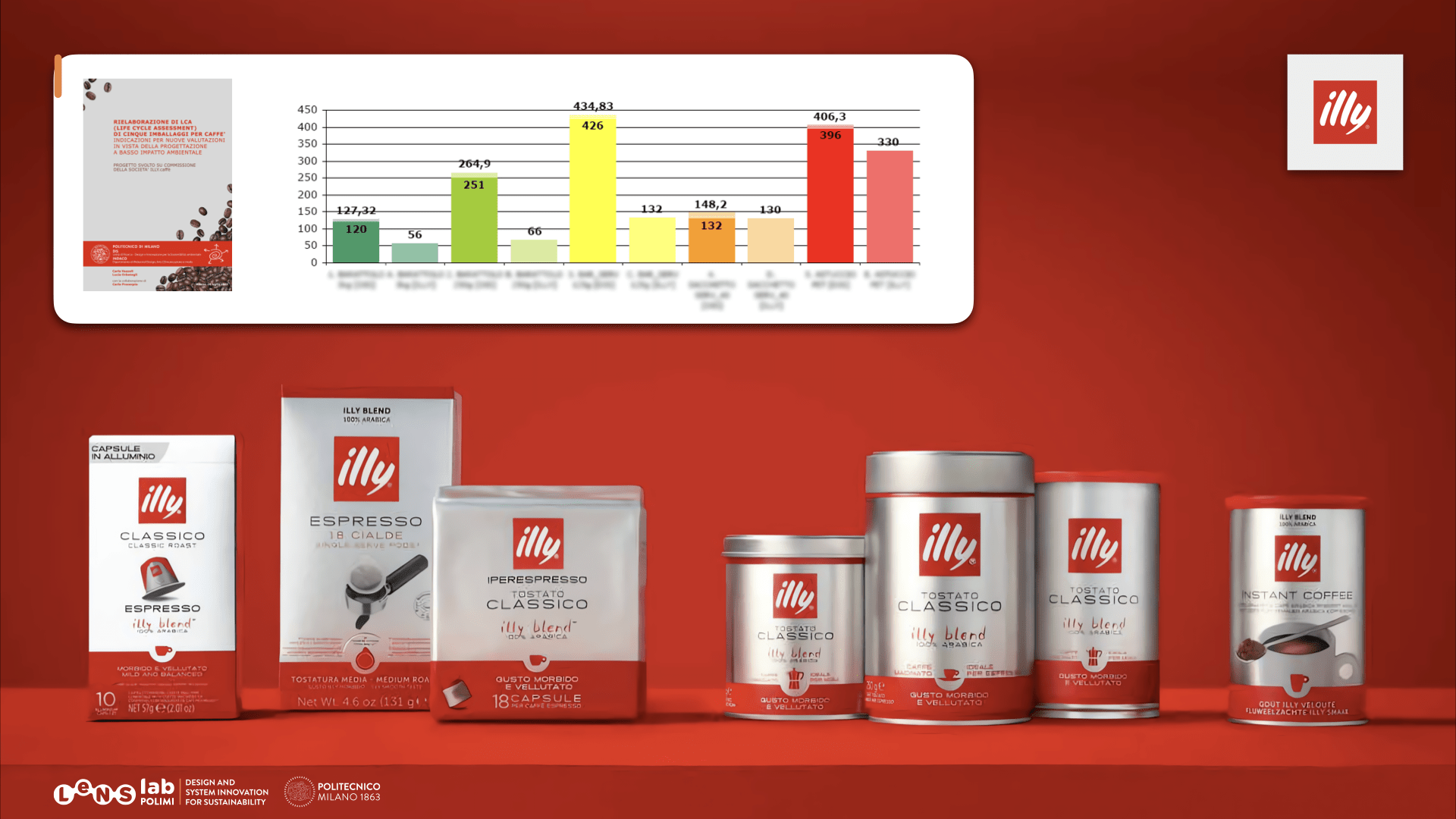
Project Case Study: Life Cycle Assessment of Mannequins for Bonaveri.
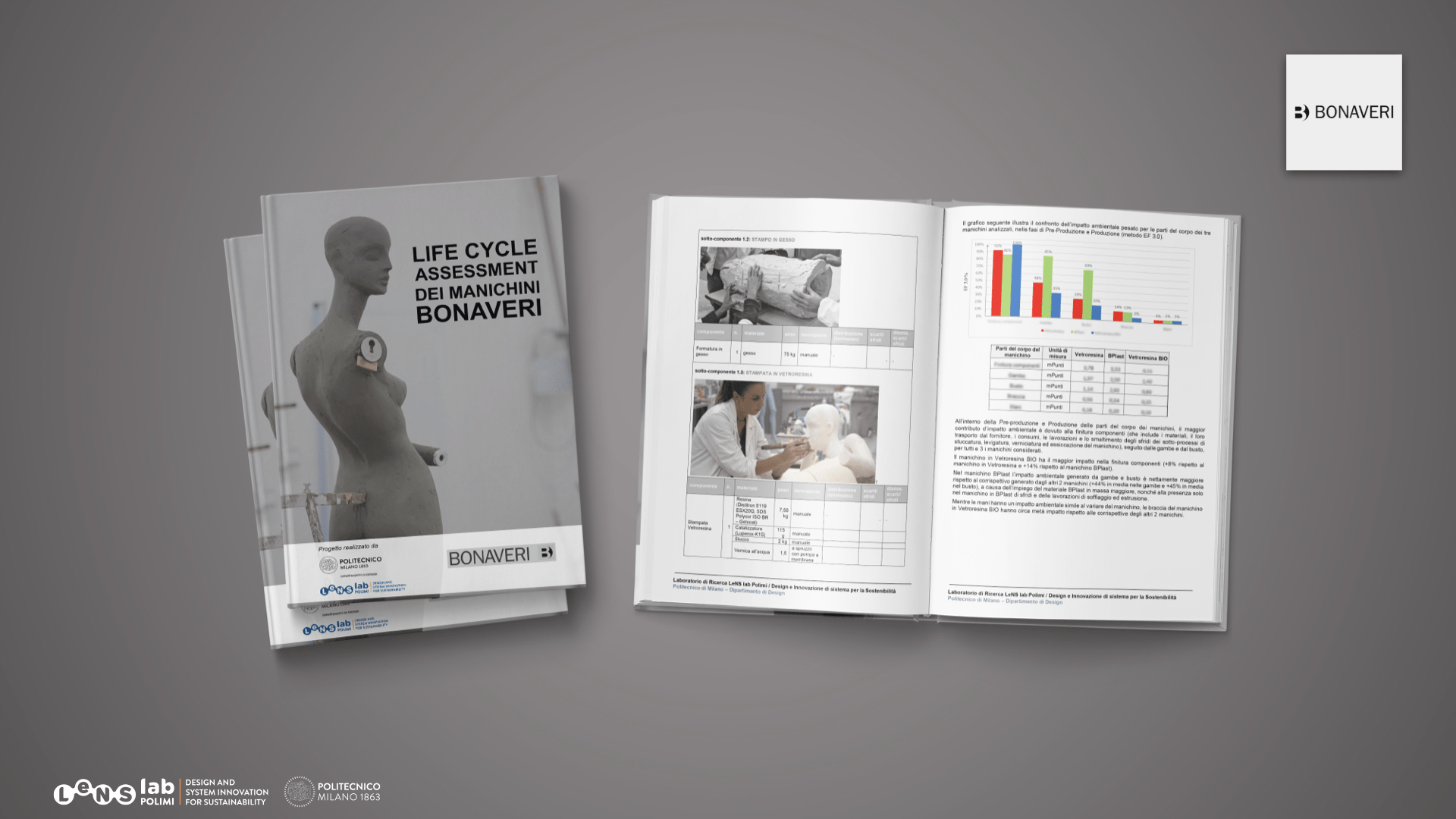
This will close in 0 seconds
The guideline manual provides operational indications to guide design culture and practice towards low environmental impact solutions. Starting from environmental impact assessments of the company’s products and the identification of design intervention priorities, an organic set of possible strategies, guidelines, and design recommendations is developed, following the criteria of LCD (Life Cycle Design or ecodesign). The guideline manual represents a fundamental and strategic tool for those involved in product development within a specific company and/or product sector.
Consulted Organisations:


Project Case Study: Guidelines fo Designing Low Environmental Impact Spiral Vending Machines for Necta.
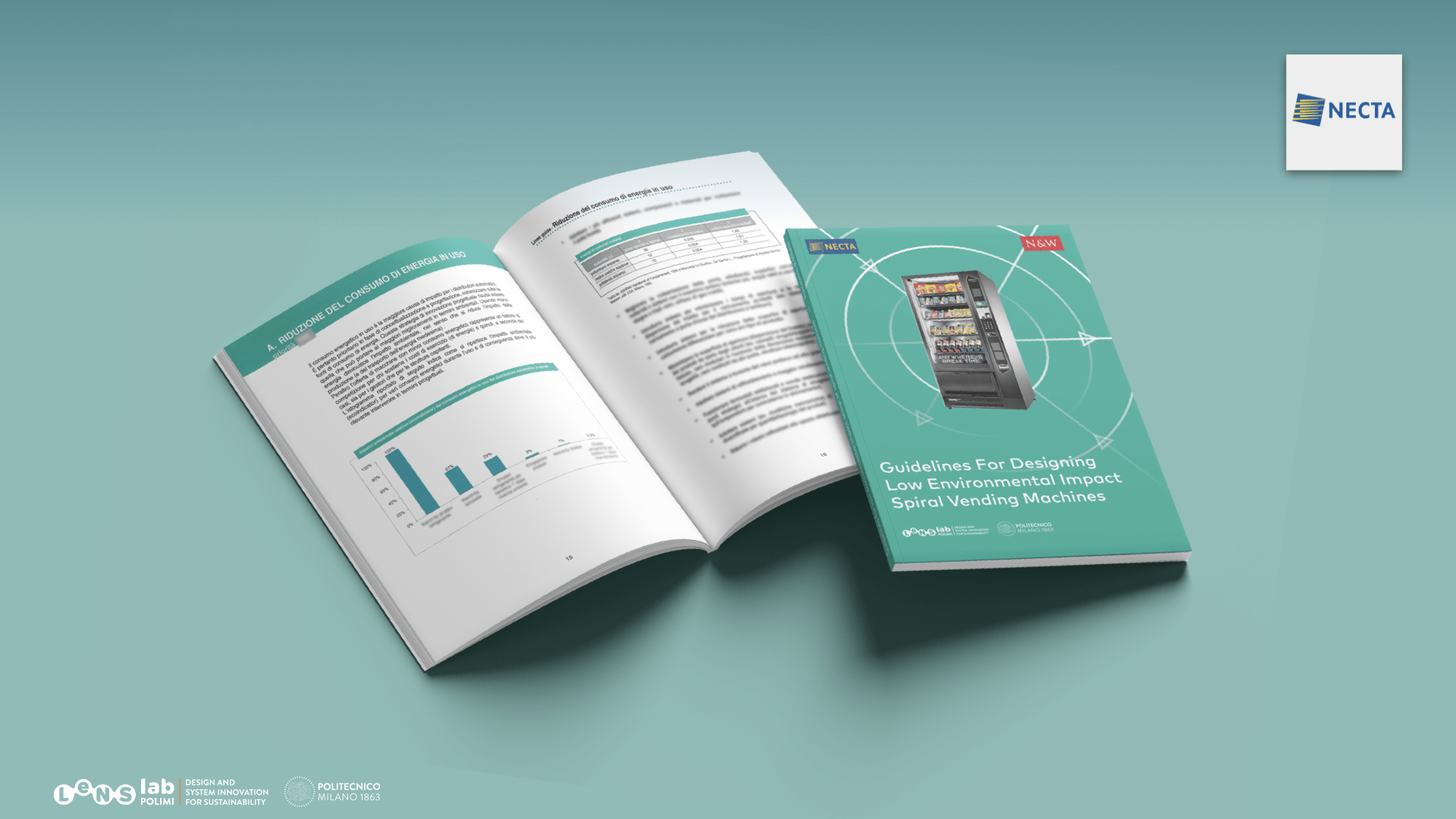
Project Case Study: Handbook of Guidelines to Design Sustainable De'Longhi Products.
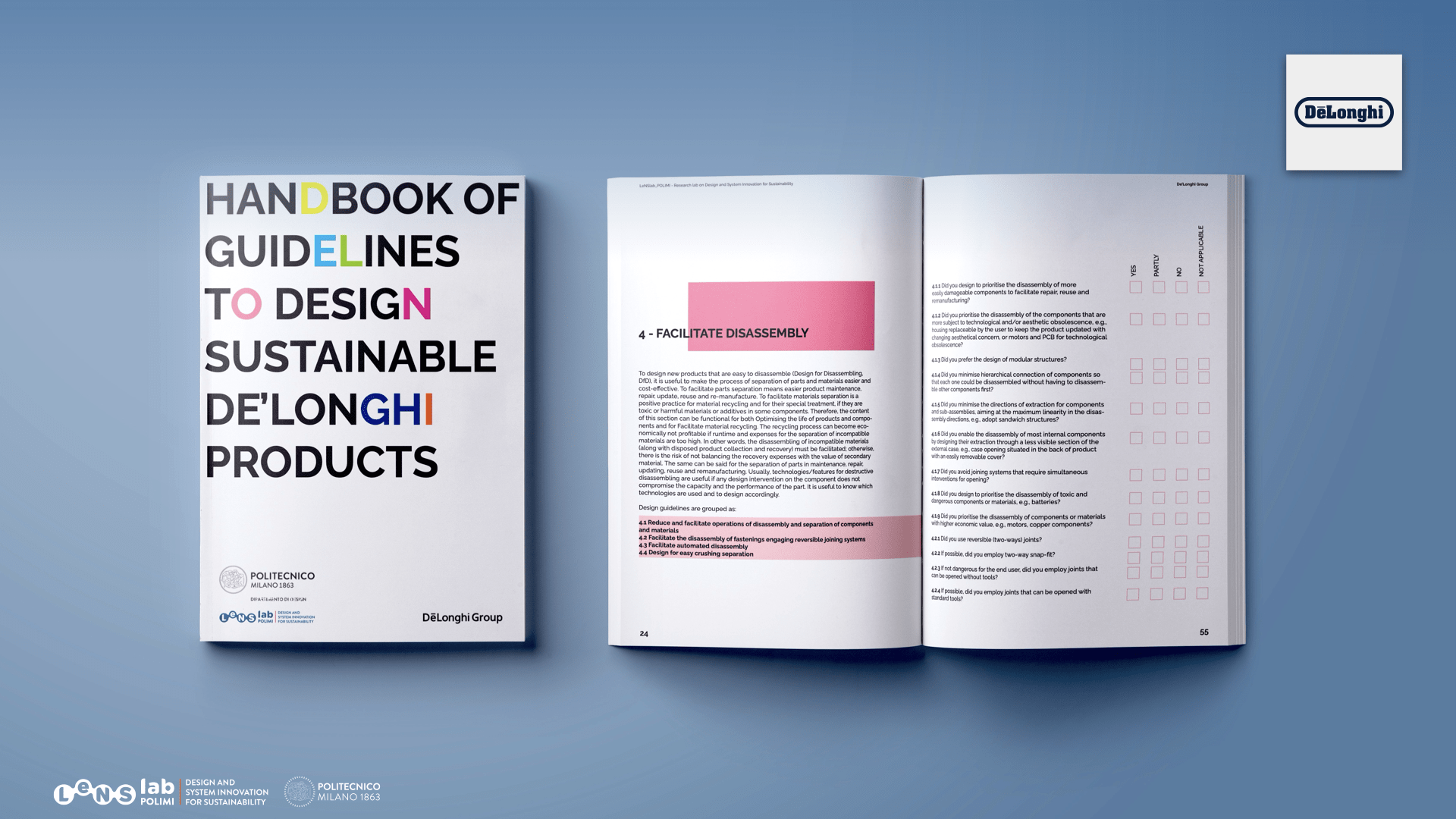
This will close in 0 seconds
The objective is to define procedures and tools that integrate Life Cycle Design (LCD) criteria into the company's product development process. Starting from an analysis of the existing development process and its environmental criticalities, the aim is to identify the skills, tools (to be acquired or developed), and possible procedures necessary to integrate environmental requirements into the product development process of a specific company and/or product sector.
Consulted Organisations: 
Project Case Study: Product Design for Sustainability Support for Artemide.
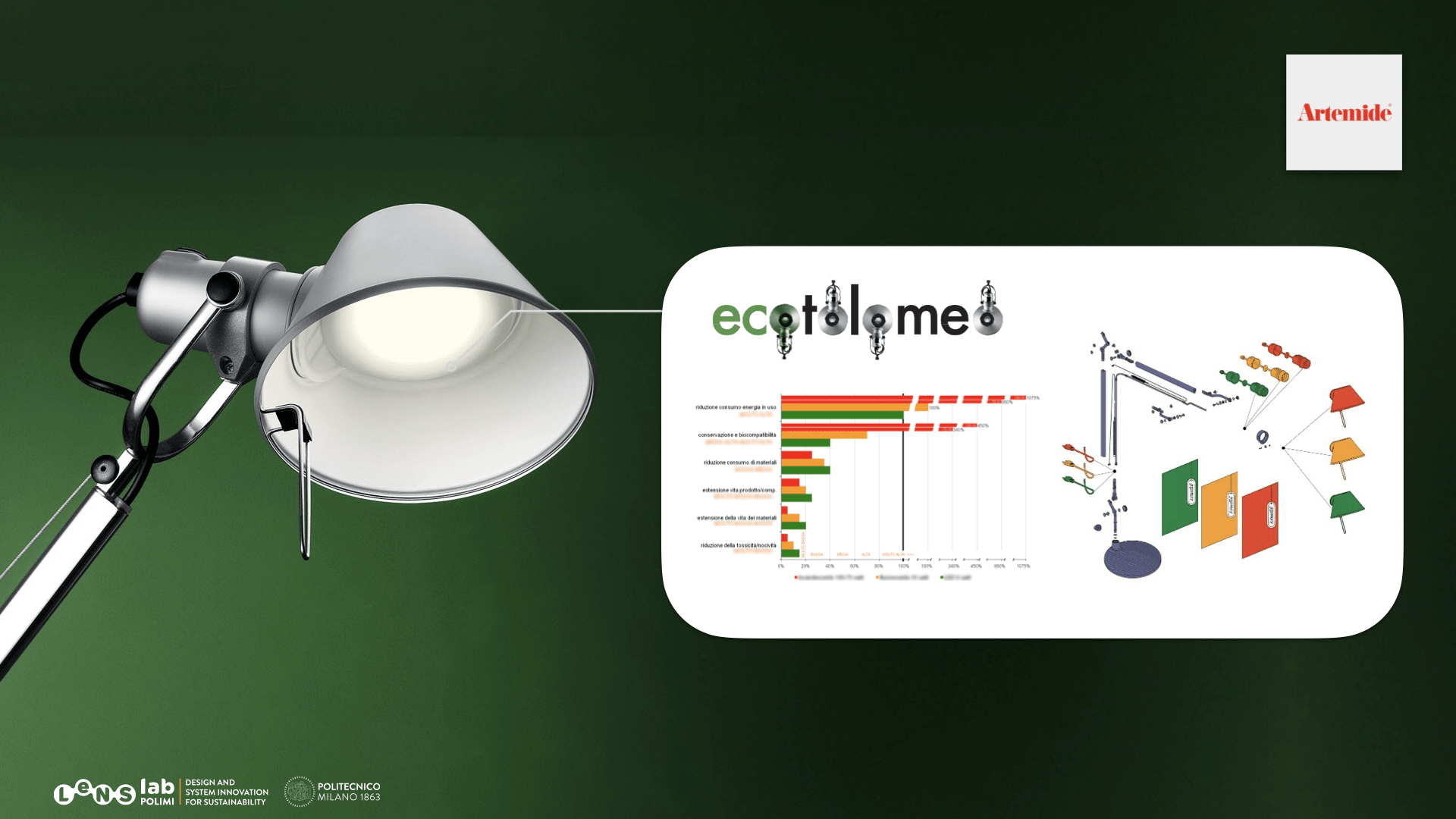
Project Case Study: Eco-Efficient Product-Service System Concepts Design for Kone.
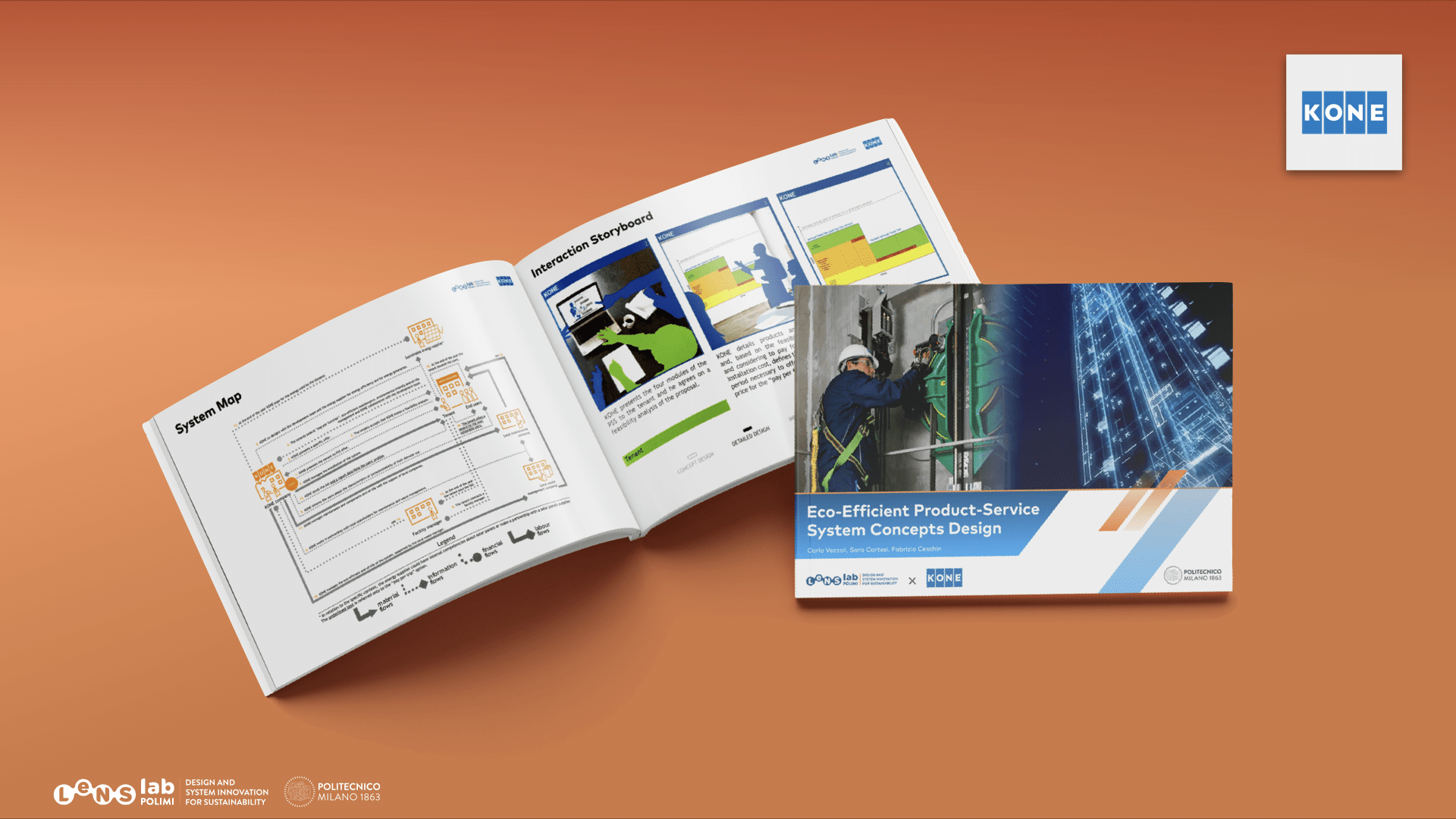
This will close in 0 seconds
The objective is to provide methodological and instrumental support in the design process of eco-efficient products, services, and systems. The support may be limited to concept development or, if required, may extend to the executive design specifications.
Consulted Organisations:


Project Case Study: Digital Tool for Designing Sustainable Bean-to-Cup Coffee Machines for De'Longhi.
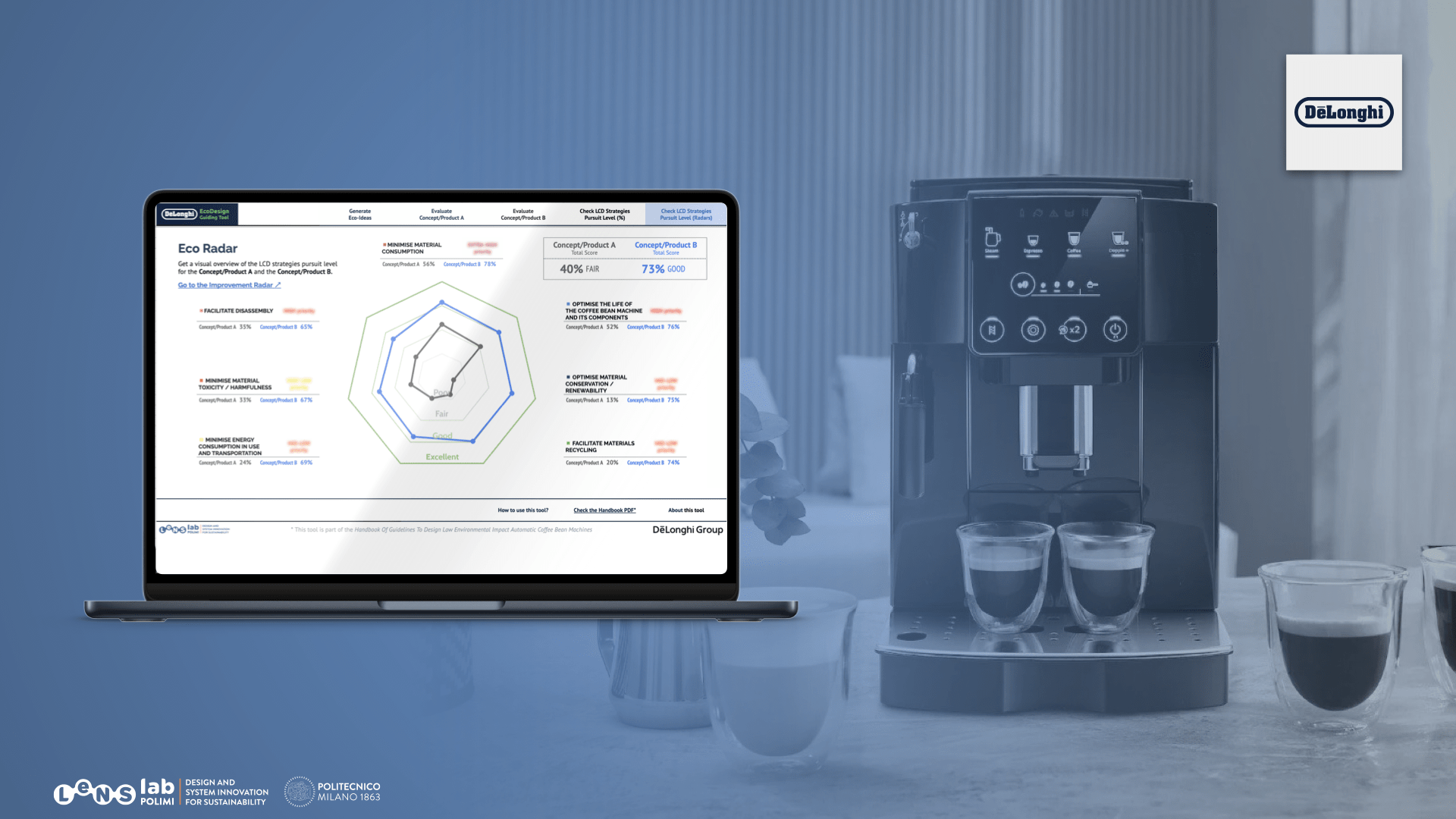
This will close in 0 seconds
The objective is to propose innovative offer models to a company and/or within a specific sector that are sustainable from environmental, economic, and social perspectives. The development of scenarios involves the creation of a set of possible visions, each described individually through ideas and clusters of ideas, all of which are potentially sustainable.
Consulted Organisations:

Project Case Study: The sustainability Design Orienting Scenario for Tetra Pak.
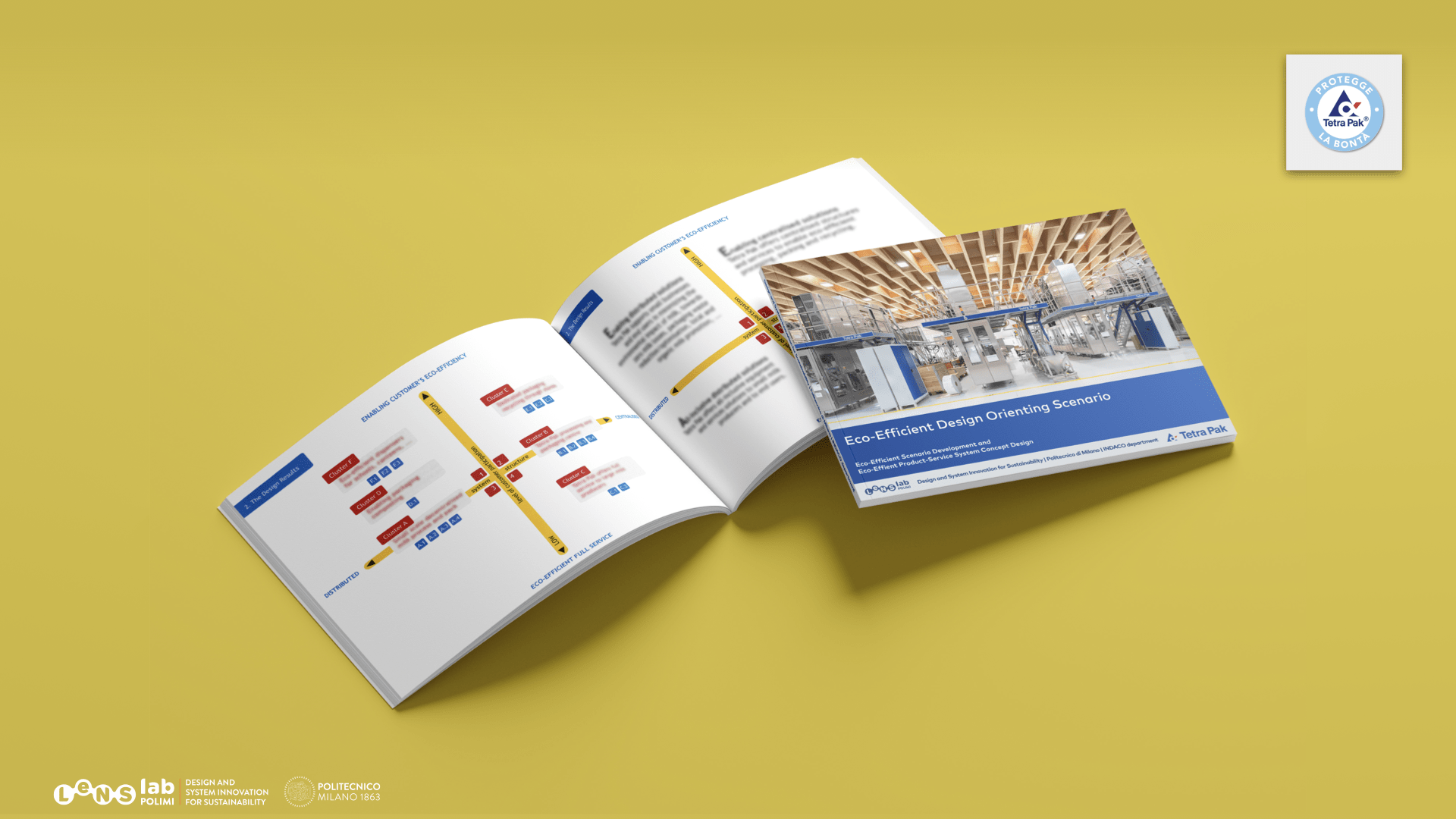
This will close in 0 seconds
The aim is to provide an update on the integration of environmental requirements to those involved in the development of products and services. In particular, modules/courses are offered on the topics of Life Cycle Design (LCD), Life Cycle Assessment (LCA), and System Design for sustainability, focusing on the skills and tools suited to the specific production context of the company and/or sector.
Consulted Organisations: 
Project Case Study: Update Programme on System Design for Sustainability and Design for Serviceability in the HVAC Industry for Carrier.
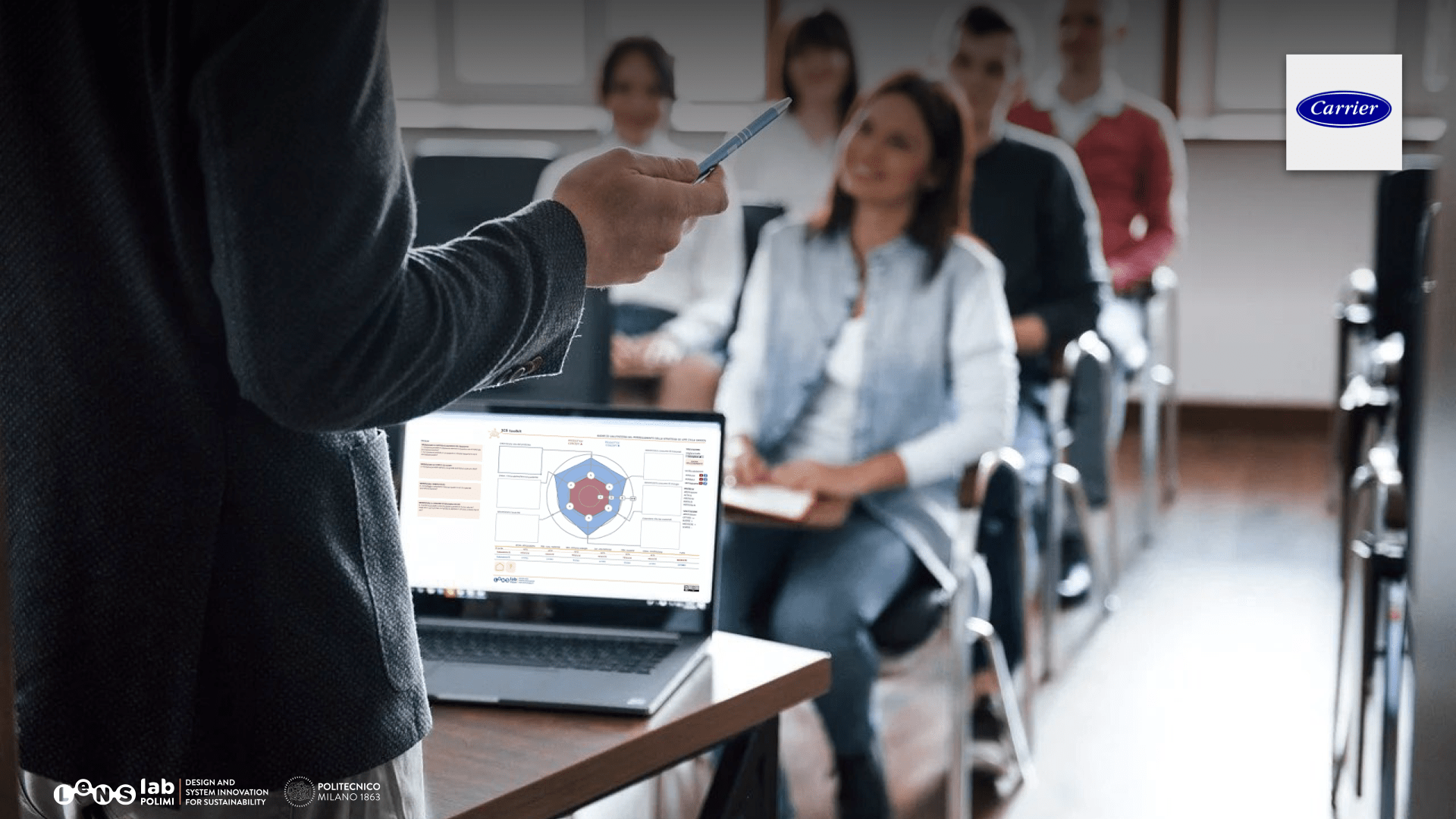
This will close in 0 seconds